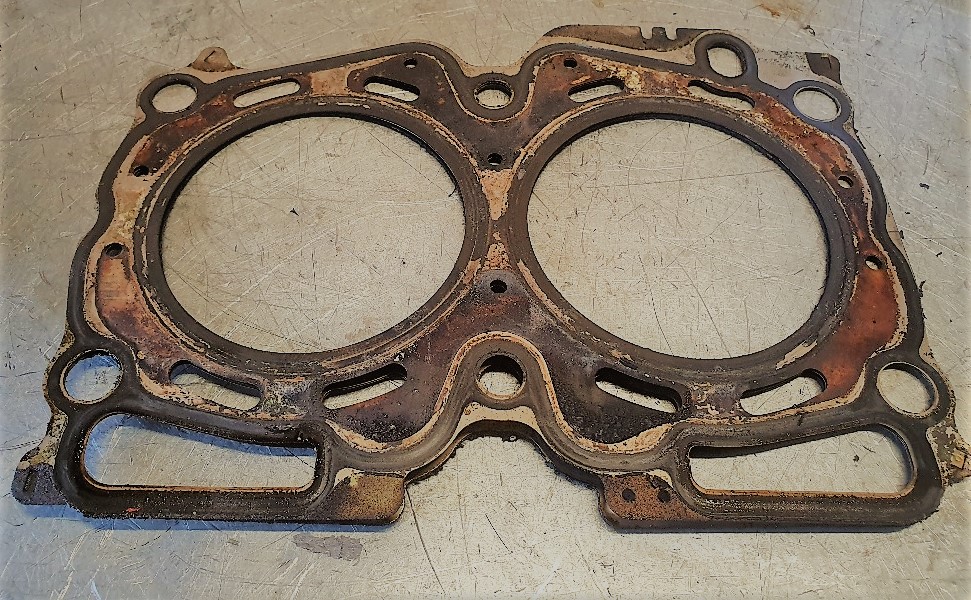It seems daily we read about or directly hear about someone disappointed with their Subaru’s ‘weak’ head gaskets.
The term ‘blown head gasket’ seems to be regularly used amongst Subaru owners and enthusiast chat groups. The fact is, rarely does the post Year 2000 Subaru blow the head gasket. Before 2000 it could happen, but it still wasn’t a common problem.
So, why do we hear so much about head gaskets and why is the year so important?
Early engines had a head gasket that was made from a compressible fibre material with metal rings around the important parts to contain the extreme pressures of combustion. These were known as composite gaskets, and they had their limitations. They would sometimes need to be re-tensioned as the material compressed over time.
If the metal ring had any breach of sealing, the fibre material backing it up would ‘blow’ out due to the extreme pressure which would result in a catastrophic failure.
The term ‘blown head gasket’ refers to a hole blown through the sealing material to allow combustion pressures to escape. Also, it can allow coolant to enter the cylinder or mix with the oil. The loss of cylinder compression usually causes an engine to run on less than all its cylinders.
Composite style head gaskets have almost completely vanished from modern engines, Subaru along with most manufacturers have abandoned them in favour of metal shim style gaskets. Sometimes referred to as MLS gaskets they are a thin stainless steel shim or layers of thin steel shims riveted together, sometimes with a sealing coating.
Better gasket technology and better surface finishing machinery and assembly process have made the compressible nature of the fibre composite head gasket redundant. This shim style of head gasket started being phased in around the mid-’90s on Subaru’s and by 2000 was across the board.
The style of the gasket is exceptionally robust and almost impossible to blow as it’s harder than the surrounding aluminium cylinder block and head. As they don’t compress over time, re-tensioning was also a thing of the past.
So why the bad reputation?
Well, the downside is Steel shim gaskets are not at all tolerant of surface imperfections. The surfaces either side of the gasket must be perfectly smooth and perfectly flat. If there’s no compressibility in the gasket if the surfaces are not 100% flat, part of the surface will have less sealing pressure than the rest, and a leak can occur.
If a Subaru engine is run low on coolant or very hot, either of the two-cylinder heads can warp enough to let the slightest amount of gas leak past the gasket. Often a breach of the head gasket is a result of an overheating engine, not the initial cause.
Frequently this type of slight leak will only occur under certain circumstances. It’s not uncommon on turbo engines to only breach the gasket under high boost — six-cylinder Liberty and Outback only under load such as going up a long hill.
One thing for sure, once a breach has occurred, it won’t fix itself. Using ‘stop-leak’ chemical type products only make it harder to repair later.
A Subaru with metal head gaskets that leak will rarely mix the oil into the coolant and vice versa or lose a cylinder. Most of the time, they appear okay, run smoothly and may have coolant consumption (be aware of this when purchasing a used car).
The other type of failure that has contributed to the myth of ‘weak’ gaskets is the external oil leak that plagues many 2.5 litre SOHC engines. (all the non-turbo four-cylinder Liberty, Outback and Forester since around early 2000 to 2011-12)
We regularly speak to concerned owners seeking a second opinion. Routine maintenance service on their Subaru has resulted in a blown head gasket which needs immediate repair and may cost thousands of dollars.
The reality is that it probably has an oil leak at the head gasket. Yes, it costs thousands to repair correctly, and yes, it will need repair…eventually.
Will the car break if you continue to drive it as it is?
The answer is, probably not. You need to be aware that they make a mess, and in most cases, they eventually stink of burning oil. Unless the engine runs low on oil, usually it’s a repair that can be postponed until a suitable time without any significant risks.
Typically the leak is not pressurised oil; it’s only a drain passage that seeps oil very slowly. The problem stems from the type of coating on the original gasket and the design. Almost all these engines leak here to some extent at some time in their lives.
If you’ve had a diagnosis of a ‘blown gasket’ and are worried about the consequences of driving with this fault; please ask us to inspect your car. We can advise on the severity and likely timeframe of a cost-effective repair.
Feel free to ask our opinion, it costs nothing and may put your mind at ease as often the repair can be delayed until an appropriate time. Once rectified with a revised gasket it’s rare that this will re-occur.

